Corn residues are a major factor contributing to lower yields for corn following corn compared to corn rotated with soybean, particularly under no-till management.
Key Research Findings
- A four-year study was conducted in Missouri to evaluate the effects of residue management practices and hybrids on stand density and yield for no-till continuous corn.
- Residue management treatments included: (1) fall N application; (2) fall stalk chopping; (3) partial stover harvest in the fall; (4) use of row cleaners at planting in spring; and (5) a control with no residue management.
- Fall stalk chopping and partial stover harvest resulted in 6 percent and 12 percent greater stand densities compared to no residue management.
- Yield was increased by 16 percent (24 bushels per acre) for partial stover harvest compared to no residue management. None of the other residue management treatments produced better yields than no residue management.
- Two Pioneer hybrids were evaluated: 33W84 (HXX,LL,RR2) and 33D14 (HXX,LL,RR2). In two of the four study years, 33W84 yielded more than 33D14, but there was no indication that either hybrid responded better than the other to high residue conditions.
Introduction
Most research agrees that continuous corn yields less than corn rotated with soybean. A large part of this yield difference is related to interference from previous years’ stover when corn follows corn. Therefore, residue management is an important consideration in a continuous corn cropping system. Most often, tillage is used to manage corn residues. While tillage can be effective in reducing yield depression of corn following corn, it is also an added management cost and can leave soil vulnerable to erosion and deplete soil organic matter. No-till systems avoid tillage costs and improve soil quality, but can introduce additional risk of poor stand establishment and reduced yield, particularly in areas with heavy, wet soils that warm slowly in the spring. Alternative residue management options are needed to improve no-till continuous corn production in these areas.
Residue Management Concerns for Continuous Corn
- Stover pushed into the seed furrow during planting can interfere with proper seed placement, reduce seed-to-soil contact and delay germination. Stover also can present a physical barrier to planting and emergence.
- Stover can reduce soil temperature, which delays germination and reduces root growth and nutrient uptake.
- Stover in contact with corn seedling roots may have an allelopathic (toxic) effect, resulting in stunting and delayed development.
- As stover breaks down, it ties up soil nitrogen, which is then unavailable for crop uptake. N tie-up by stover is particularly problematic for no-till.
- Excess stover increases the risk of pest infestations, including insects, diseases and rodents. Excess stover can also bind with and inactivate soil-applied herbicides.
Primary Research Objectives
The primary objective of this study was to identify cost-effective management practices for reducing the negative effects of stover on stand density and yield of no-till continuous corn. A secondary objective was to evaluate the response of two Pioneer® brand hybrids to no-till continuous corn production.
Study Description
Location and Residue Management Treatments
This experiment was conducted at the Bradford Research and Extension Center near Columbia, Mo. The predominant soil type was a Mexico silt loam. The experiment evaluated five residue management treatments. Treatments were: spraying 40 lb/acre liquid N on the residue in the fall (Fall N), fine chopping of stalks in the fall (Fall Stalk Chop), removing stover by baling in the fall (Bale and Remove), using row cleaners when planting in spring (Row Cleaners), and no residue management (None).
Hybrid Selection
Two Pioneer® hybrids, 33W84 (HXX,LL,RR2) and 33D14 (HXX,LL,RR2), were selected for evaluation in the study. The hybrids are similar for many traits including comparative relative maturity (CRM) ratings in the range of 111 to 113. Compared to 33D14, 33W84 is characterized by greater early vigor and increased foliar disease resistance, which should make it generally better suited for production in high residue environments.
Crop Management
A four-row Kinze planter was used to plant the two hybrids each year in mid-April. In three of the years, plots had to be replanted in late May due to cool, wet spring conditions and generally poor stand densities (<10,000 plants/acre). In all study years, plot dimensions were 10’ wide x 60’ long consisting of four rows on 30-inch spacing. Planting rates were 30,000 kernels/acre in 2008 and 32,000 kernels/acre in the other three years. Nitrogen fertilizer was uniformly broadcast across all treatments as ammonium nitrate (NH4NO3) at a rate of at least 200 lb N/acre soon after planting. This experiment was conducted in the same field block each year. Because of this, residue management treatments and hybrids were applied to the same plots each year, and the results of the study allow for conclusions regarding longer term management trends.
Field Measurements
Stand density was measured each year by counting the number of emerged plants in two 20-foot row sections in the center of the plots. The center two rows in each plot were harvested each year to determine grain yield, which was adjusted to 15.5 percent moisture.
Results
1. Did residue management treatments reduce the amount of corn stover?
Yes. Averaged over the four years of the study, stover amounts were reduced by 9, 16 and 53 percent, respectively, by the Fall N, Fall Stalk Chop, and Bale and Remove treatments. Stover amounts were not measured for the Row Cleaners treatment because in these plots, stover was not removed from the field, but rather moved from within the row area. Fall application of liquid N had only a small effect on residue levels. Stalk chopping likely reduced stover levels by decreasing particle size and increasing decomposition rates. Small particles break down more rapidly because they have a larger surface area exposed to microbial action. The Bale and Remove treatment involved mowing, raking, baling and removing approximately half of the stover in the field. This level of removal is the effective maximum harvest rate for current rake and bale machinery.
2. Did residue management treatments affect corn stands?
Yes, but only for two of the treatments (Figure 2).
Effects Of Residue Management Treatments On Stand
Density For No-Till Continuous Corn. Results Are Averages Of A
Four-Year Field Study In Central Missouri.
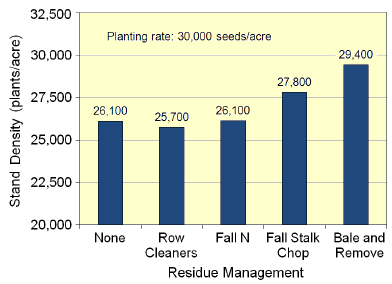
|
Averaged over the four-year study period, rank-order stand densities (plants/acre) were: Row Cleaners (25,700); None (26,100); Fall N (26,100); Fall Stalk Chop (27,800); and Bale and Remove (29,400). For Fall Stalk Chop and Bale and Remove, the only two treatments that resulted in significantly greater stands than the control, four-year average plant counts were only 6 and 12 percent greater than no residue management. In three of the four years, plots required replanting to obtain acceptable stand densities. Replanting occurred after soils had warmed and dried, so stand differences among residue management treatments were probably reduced in 2009, 2010 and 2011. In 2008, plots were not replanted and the treatment that removed the most residue (Bale and Remove) increased stand density by 44 percent compared to no residue management. These results indicate that residue management is likely much more important when planting corn into cool and wet soils.
3. Did residue management treatments affect corn yields?
Yes, but only the Bale and Remove treatment significantly increased yields above no residue management (Figure 3).
Effects Of Residue Management Treatment On Grain
Yield For No-Till Continuous Corn. Results Are Averages Of A
Four-Year Field Study In Central Missouri.
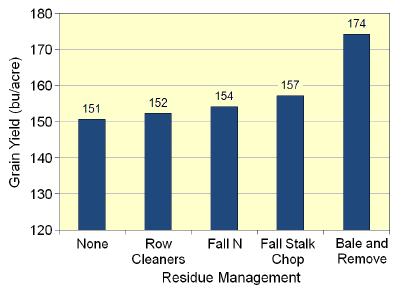
|
Averaged over the four years of the study, grain yields were 151, 152, 154, 157 and 174 bu/acre for the None, Row Cleaners, Fall N, Fall Stalk Chop, and Mow and Bale treatments. The only effective treatment, Bale and Remove, increased yield by 16 percent compared to the no residue management control. The Bale and Remove treatment yielded more than the no residue management in each of the four study years, even in years when the two treatments produced similar stand densities (Figure 4).
Grain Yield Over Four Years For No-Till Continuous
Corn With And Without Partial Stover Harvest.
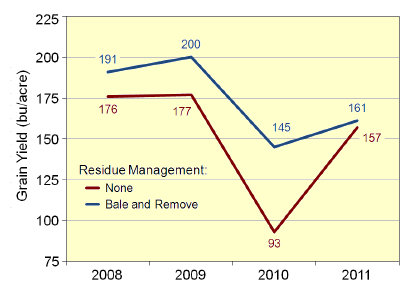
|
This study did not include a soybean rotation treatment for comparative purposes. However, in another study at the same research location, corn following soybean yielded 14 percent more than corn following corn, averaged over a six-year period.
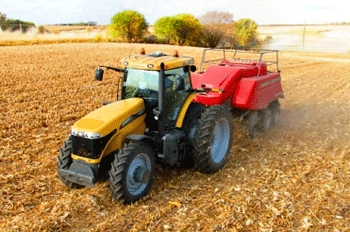 Figure 5. Growing livestock and industrial markets make baling and removing a portion of stover an attractive option for residue management in no-till continuous corn systems. |
Treatments from these two studies cannot be directly compared, but when the studies are considered together, they suggest that corn after corn with stover removal may be able to deliver similar yield advantages as corn in rotation with soybean. Several studies have shown that as much as half of the corn stover in a field can be removed without negatively impacting soil quality and productivity. No-till continuous corn systems are well suited for stover removal due to high annual organic matter inputs in conjunction with a lack of tillage, which makes it possible to sustainably harvest greater quantities of stover from these cropping systems compared to systems that include conventional tillage or soybean rotation.
4. Did hybrids respond differently to residue management treatments?
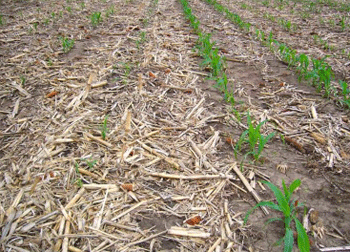 Figure 6: Emergence and crop growth in the spring with heavy (left) and light (right) corn stover on seedbed. |
Yield differences were observed between hybrids in some years, but there was no evidence that they responded differently to high residue conditions (Figure 7). In 2008 and 2010, 33W84 yielded more than 33D14. In contrast, the two hybrids produced similar yields in 2009 and 2011. Yield differences in 2008 may have been the outcome of greater stand density for 33W84 compared to 33D14 (data not shown). However, the two hybrids had similar stand densities in 2010, even though 33W84 produced greater yields that year. No interaction was detected between hybrids and residue management treatments, indicating that the two hybrids responded similarly to varying residue levels induced by different residue management practices. Therefore, while there may be differences among certain hybrids in response to residue conditions, there are likely more important traits to be considered by producers selecting hybrids for high residue environments.
Grain Yield Over Four Years for Two Hybrids, 33W84 and 33D14, Under no-till Continuous Corn Management. Results are Averaged Across Residue Management Treatments.
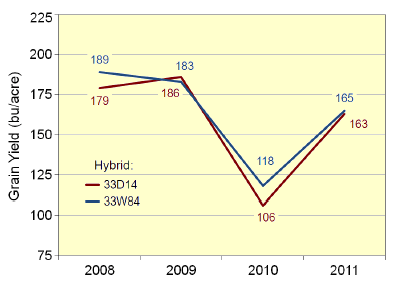
|
Conclusions
The results of this study highlight the importance of effective residue management for achieving optimum stand density and high grain yield in no-till continuous corn production. However, study results also demonstrated that several commonly used residue management practices, including fall N application and the use of row cleaners at planting, were largely ineffective in improving either stand density or grain yield. Of the management practices evaluated, only fall stalk chopping and partial stover harvest resulted in improved stand density compared to no residue management, and only partial stover harvest led to improved stand density and yield.
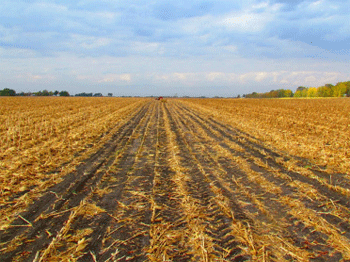 Figure 8. Pioneer research plot following corn stover harvest in the fall |
No-till continuous corn producers who have livestock or access to stover markets should consider partial stover harvest as a method for effectively managing corn residues. A previous Crop Insights article2 on Sustainable Corn Stover Harvest for Biofuel Production provides information regarding the amount of stover that needs to be retained in fields to sustain soil organic matter, as well as guidelines for determining nutrient replacement value of harvested stover.
The Pioneer Crop Management Research Awards (CMRA) Program provides funds for agronomic and precision farming studies by university and USDA cooperators throughout North America. The awards extend for up to four years and address crop management information needs of Pioneer agronomists, sales professionals and customers. This Crop Insights research update was adapted from the final report submitted by Dr. Bill Wiebold, University of Missouri, Division of Plant Sciences, for his CMRA project entitled, “Mitigation of Stover Effects on Yield in Continuous Corn Planted without Tillage.” This project was sponsored by Pioneer’s Central Business Unit and coordinated by Pioneer Agronomy Research Manager, Scott Nelson and Pioneer Technical Product Manager, Greg Luce.
Figure 1. Residue management can be particularly challenging in no-till systems where stover accumulation can diminish seedling emergence and early growth.






Post a comment
Report Abusive Comment